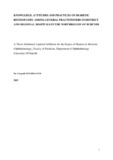| dc.description.abstract | Background: In Burundi, diabetic retinopathy is yet to be recognised as an important public health problem. Priority is given to infectious diseases such as malaria, tuberculosis, diarrheal diseases, acute respiratory infections and HIV/AIDS all of which have preventive and management strategies. In addition, there is poor knowledge of diabetic retinopathy. Poor knowledge is not limited to patients alone, studies evidenced that health care workers who are supposed to be better informed do not have good knowledge of the disease either. Despite the growing diabetic retinopathy burden, the disease continues to receive a relatively low public health priority in the country.
Objective: To establish the knowledge, attitude and practice on diabetic retinopathy among general practitioners working in District and Regional Hospitals in the North Region of Burundi.
Methodology: The study was a descriptive cross-sectional study. It was carried out at District and Regional Hospitals in the North Region of Burundi. Study targeted General Practitioners working at these health facilities. Study period was from 21January 2014 to13 January 2015. 74 General Practitioners was the sample size. A questionnaire, written in English then translated into French was used to collect information from the respondents. Categorical variables were analysed using frequencies and percentage. Continuous variables were summarized using mean, percentile, range, and standard deviation, where appropriate. For analytical statistics Chi-square test statistics was used to assess the relationship between two categorical variables. Significant differences and associations were determined by p values of less than 0.05.
Results: The study participants generally had a poor knowledge on DR. Participants had good knowledge about relationship between DR and others end organs which can be affected by microvascular complication of diabetes mellitus like kidney 62 (76.5%). Participants had very poor practice on screening for DR, with only 22.2% testing the vision in a year and only 5(6.2%) attempted fundus examination on their diabetic patients. The participants had good practice in referral of diabetic patients 66(81.5%).The majority of general practitioners did not have access to an ophthalmoscope at their work place 77(95.1%). | en_US |
| dc.description.department | a
Department of Psychiatry, University of Nairobi, ; bDepartment of Mental Health, School of Medicine,
Moi University, Eldoret, Kenya | |

